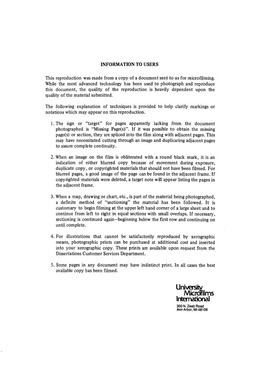| dc.contributor.author | Wood, D. Scott | en_US |
| dc.date.accessioned | 2013-08-16T12:28:47Z | |
| dc.date.available | 2013-08-16T12:28:47Z | |
| dc.date.issued | 1982 | en_US |
| dc.identifier.uri | https://hdl.handle.net/11244/5059 | |
| dc.description.abstract | The stability (measured using matrix correlations) of phenetic classifications based on partitions of continuous morphometric data (skeletal measurements from three groups of birds) was compared for analyses involving two transformations: removal of size and removal of the common part (an estimate of the taxon of the study group). Linear regression was used in both transformations to remove that portion of the variance accounted for by the estimate of either size or the common part. The size estimate was a composite variable computed as the mean of three measurements. The estimate of the common part was the set of measurements used to form the data set to be analyzed but taken on a similar species outside the study group. Results derived from three similarity measures (product-moment correlations, average taxonomic distances and Manhattan distances) were also compared. In all cases distance measures produced significantly higher average congruence between classifications than did correlations. For two data sets the transformation to remove the common part resulted in significantly higher mean congruence (for distances) than did the transformation to remove size; for the third data set there was no significant difference. | en_US |
| dc.description.abstract | The major skeletal elements of all 17 species of storks were analyzed using techniques from multivariate statistics to assess the phenetic affinities within the family Ciconiidae. The common-part transformation and the use of taxonomic distances clustered by the unweighted pari-group method with arithmetic averages gave significantly more stable phenetic arrangements than the other methods used. Kahl's data on courtship behavior in the Ciconiidae were recoded and analyzed from a phenetic viewpoint. The resultant classification reflects his published results except for the placement of Ciconia nigra and the genera Ephippiorhynchus and Jabiru. Classifications based on skeletal morphology are highly congruent with those recalculated from the behavioral data. The classification suggested by both sets of data is similar to that proposed by Kahl with the following changes: (1) Jabiru is included with Ephippiorhynchus; (2) Ephippiorhynchus is transferred into the Ciconiini. | en_US |
| dc.format.extent | v, 116 leaves : | en_US |
| dc.subject | Biology, Zoology. | en_US |
| dc.title | A phenetic assessment of the Ciconiidae (Aves) using skeletal morphology. | en_US |
| dc.type | Thesis | en_US |
| dc.thesis.degree | Ph.D. | en_US |
| dc.thesis.degreeDiscipline | Department of Biology | en_US |
| dc.note | Source: Dissertation Abstracts International, Volume: 43-09, Section: B, page: 2828. | en_US |
| ou.identifier | (UMI)AAI8302464 | en_US |
| ou.group | College of Arts and Sciences::Department of Biology | |
